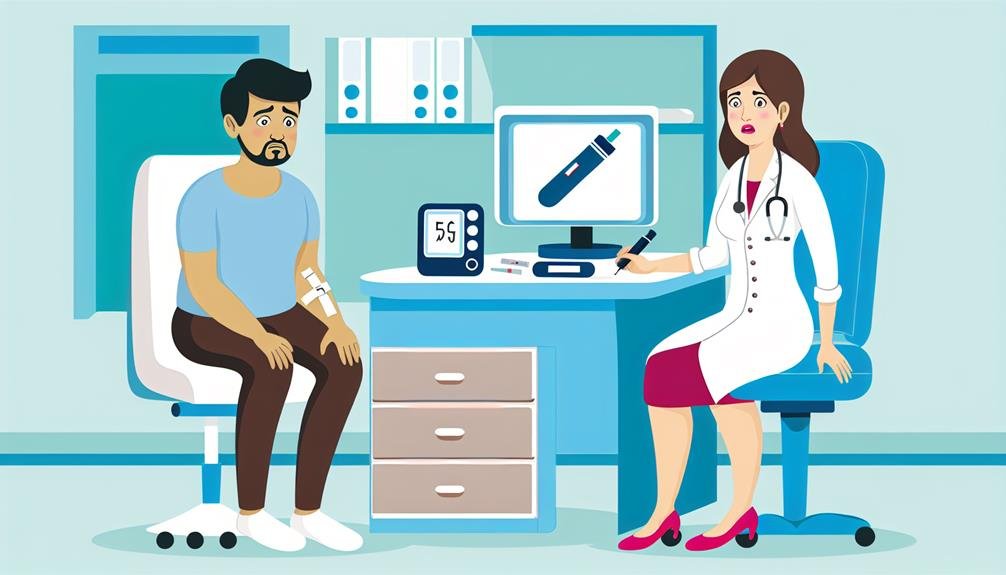
When it comes to diabetes diagnosis, understanding the different tests available is crucial for early detection and effective management. From A1C to fasting blood sugar tests, each method provides unique insights into your body’s glucose levels. But how do these tests work, and what do they reveal about your health? Let’s explore the intricacies of diabetes diagnosis and how it can impact your overall well-being.
Key Takeaways
- Blood tests measure glucose levels for diagnosis.
- A1C test evaluates average blood sugar over 2-3 months.
- Fasting Blood Sugar Test checks levels after overnight fast.
- Oral Glucose Tolerance Test assesses sugar processing.
- Random Blood Sugar Test measures levels at any time.
Importance of Early Detection
Early detection of diabetes is crucial for effective management and prevention of complications. By identifying diabetes in its early stages, you have a greater chance of controlling your blood sugar levels and reducing the risk of long-term complications such as heart disease, nerve damage, kidney problems, and vision loss. Research has shown that early intervention can significantly improve outcomes for individuals with diabetes.
Regular screenings and check-ups are essential for catching diabetes early, especially if you have risk factors such as obesity, family history, or a sedentary lifestyle. These screenings often involve simple blood tests that measure your blood sugar levels. By staying proactive with your health and attending routine appointments, you can stay ahead of any potential issues and work with healthcare professionals to develop a personalized management plan.
Common Symptoms of Diabetes
You may notice early warning signs such as increased thirst, unexplained weight loss, and fatigue, which could indicate high blood sugar levels and the possibility of diabetes.
Pay attention to symptoms like frequent urination, especially during the night, as this can be a sign of your body trying to rid itself of excess sugar.
If you experience these symptoms frequently, it’s crucial to consult a healthcare professional for proper evaluation and diagnosis.

Early Warning Signs
A variety of common symptoms may serve as early warning signs indicating the presence of diabetes. These signs include frequent urination, excessive thirst, unexplained weight loss, increased hunger, fatigue, blurry vision, and slow-healing sores.
When your blood sugar levels are high, your body tries to remove the excess sugar through urination, leading to increased thirst and frequent trips to the bathroom. The lack of energy and weight loss occur as your body fails to properly utilize glucose for energy. Blurry vision can result from the changes in fluid levels caused by high blood sugar.
If you notice these symptoms persisting, it’s essential to consult a healthcare professional for proper evaluation and diagnosis.
Blood Sugar Levels
Blood sugar levels play a critical role in the diagnosis and management of diabetes, as they are key indicators of the body’s ability to regulate glucose effectively. Monitoring blood sugar levels is essential for individuals with diabetes to prevent complications. Here is a breakdown of blood sugar levels and what they indicate:
| Blood Sugar Level | Interpretation | Action |
|---|---|---|
| Below 70 mg/dL | Hypoglycemia (low) | Consume a fast-acting carbohydrate source like juice or glucose tablets. |
| 70-130 mg/dL | Normal | Maintain a healthy lifestyle and continue regular monitoring. |
| Above 180 mg/dL | Hyperglycemia (high) | Take insulin or other medications as prescribed. Evaluate diet and exercise habits. |
Understanding these levels can help you manage your diabetes effectively.
Frequent Urination
Experiencing frequent urination is a common symptom associated with diabetes, indicating the body’s struggle to regulate blood sugar levels effectively. When blood sugar levels are high, the kidneys work to filter and absorb the excess glucose. This process leads to increased urine production, causing frequent trips to the bathroom.
The body attempts to rid itself of the excess sugar through urine, resulting in dehydration if not managed properly. Frequent urination, also known as polyuria, can disrupt daily activities and affect quality of life. Monitoring fluid intake, blood sugar levels, and seeking medical advice are crucial steps in managing this symptom.
If you’re experiencing persistent frequent urination, especially accompanied by other diabetes symptoms, consult a healthcare professional for proper evaluation and guidance.
Fasting Blood Sugar Test
During a fasting blood sugar test, your healthcare provider will measure your blood glucose levels after you have refrained from eating or drinking anything except water for a specific period of time. This test is usually done in the morning after an overnight fast, which typically lasts for about 8 hours. Fasting blood sugar levels provide valuable information about your body’s ability to regulate glucose when you haven’t eaten recently.
The normal range for fasting blood sugar levels is typically between 70 and 100 milligrams per deciliter (mg/dL). Levels between 100 and 125 mg/dL may indicate prediabetes, while levels of 126 mg/dL or higher on two separate tests may suggest diabetes. It’s important to follow your healthcare provider’s instructions carefully before undergoing this test to ensure accurate results.
Fasting blood sugar tests are commonly used to diagnose diabetes and monitor blood sugar levels in individuals with diabetes. If your results are outside the normal range, further testing may be needed to confirm a diabetes diagnosis and determine the appropriate course of action.
Oral Glucose Tolerance Test
After a fasting blood sugar test, if your healthcare provider requires more detailed information about your body’s glucose tolerance, an Oral Glucose Tolerance Test (OGTT) may be recommended. During an OGTT, you’ll be asked to fast overnight and then drink a solution containing a specific amount of glucose. Blood samples will be taken at intervals over the next few hours to measure how your body processes the glucose. This test helps to evaluate how efficiently your body is able to regulate blood sugar levels after consuming a sugary drink. It’s particularly useful in diagnosing gestational diabetes or prediabetes.

The results of an OGTT can provide valuable information about your body’s ability to manage glucose and can help in identifying early signs of diabetes. It’s a more comprehensive test compared to a fasting blood sugar test, as it provides a dynamic view of how your blood sugar levels respond to a glucose challenge. If your healthcare provider recommends an OGTT, it’s important to follow the fasting instructions properly for accurate results.
A1C Test for Diabetes
When managing diabetes, understanding the importance of the A1C test is crucial. This test provides a comprehensive view of your average blood sugar levels over the past few months, aiding in treatment decisions.
Importance of A1C
Understanding the significance of the A1C test is crucial for accurately diagnosing and managing diabetes. The A1C test measures your average blood sugar levels over the past 2-3 months by assessing the amount of glucose attached to hemoglobin. This provides a more comprehensive picture compared to daily glucose monitoring.
A high A1C level indicates poor blood sugar control, increasing the risk of diabetes-related complications such as heart disease, kidney damage, and nerve problems. On the other hand, a lower A1C level signifies better management and decreased risk of complications.
Regular A1C testing helps track your progress, adjust treatment plans, and set achievable goals to maintain optimal blood sugar levels.
A1C Target Range
To effectively manage diabetes, it is essential to establish and maintain an appropriate A1C target range that reflects optimal blood sugar control. The A1C test measures your average blood sugar levels over the past 2-3 months. This test is crucial in determining how well your diabetes is controlled. Here is a table outlining the recommended A1C target ranges for individuals with diabetes:

| Diabetes Type | A1C Target Range |
|---|---|
| Type 1 | Below 7% |
| Type 2 | Below 7% |
| Pregnant | Below 6-6.5% |
| Children | Below 7.5% |
| Older Adults | Below 7.5% |
It is important to work closely with your healthcare provider to set an A1C target range that is suitable for your individual needs.
Monitoring A1C Levels
Monitoring your A1C levels through regular testing is a critical aspect of diabetes management to track your average blood sugar control over time. The A1C test measures the amount of glucose attached to hemoglobin in the blood, providing an indication of your blood sugar levels for the past 2-3 months.
For most individuals with diabetes, the target A1C level is below 7%. Regularly monitoring your A1C levels can help you and your healthcare team assess the effectiveness of your treatment plan and make necessary adjustments to maintain optimal blood sugar control.
It’s recommended to discuss your target A1C range with your healthcare provider, as individualized goals may vary based on factors like age, existing health conditions, and diabetes complications.
Random Blood Sugar Test
A random blood sugar test measures your blood glucose levels at any time of the day, without the need for fasting. This test provides a snapshot of your current blood sugar level and is often used to diagnose diabetes or monitor glucose levels in individuals with diabetes. It’s a simple procedure that involves drawing blood, usually from a finger prick, and then analyzing the sample for glucose concentration.
Random blood sugar tests are particularly useful in detecting hyperglycemia (high blood sugar) or hypoglycemia (low blood sugar) at any given moment. For individuals without diabetes, a normal blood sugar level is typically below 125 mg/dL. However, if the results show a blood sugar level of 200 mg/dL or higher, it may indicate diabetes.

It’s important to note that random blood sugar tests aren’t as reliable as fasting blood sugar tests or oral glucose tolerance tests for diagnosing diabetes definitively. If your random blood sugar test results are abnormal, your healthcare provider may recommend further testing to confirm a diabetes diagnosis and determine appropriate management strategies.
Gestational Diabetes Screening
If your random blood sugar test indicates elevated levels, gestational diabetes screening during pregnancy becomes crucial to monitor and manage blood glucose levels effectively. Gestational diabetes can develop during pregnancy, affecting around 6-9% of pregnant individuals. Screening for gestational diabetes is essential as it can lead to various complications for both the mother and the baby if left uncontrolled.
Here are some key points to consider:
- Importance of Early Detection: Gestational diabetes screening helps in early detection, enabling timely interventions to manage blood sugar levels effectively.
- Risk Assessment: Screening helps assess your risk of developing gestational diabetes based on factors like age, weight, and family history of diabetes.
- Monitoring Blood Glucose Levels: Regular screening allows healthcare providers to monitor your blood glucose levels throughout pregnancy, ensuring optimal control.
- Individualized Treatment: Screening results help in tailoring a personalized treatment plan, including dietary modifications, exercise recommendations, or insulin therapy if needed.
Continuous Glucose Monitoring
Continuous Glucose Monitoring (CGM) offers a real-time look at your glucose levels, providing valuable insights into fluctuations throughout the day.
The accuracy of CGM systems in measuring glucose levels can help you make informed decisions about your diabetes management.
Benefits of Continuous Monitoring
Implementing continuous glucose monitoring in diabetes management provides valuable insights into real-time fluctuations in blood sugar levels, enabling more precise adjustments in treatment strategies. This technology offers several benefits:

- Enhanced Awareness: Continuous monitoring helps you understand how different factors like food, exercise, and stress impact your blood sugar levels.
- Early Detection: It allows for the early detection of hypoglycemia or hyperglycemia, helping prevent severe complications.
- Improved Control: With real-time data, you can make immediate changes to your treatment plan, leading to better glycemic control.
- Personalized Care: Continuous monitoring provides individualized data that can be used to tailor treatment plans according to your specific needs.
Accuracy in Glucose Levels
Achieving optimal glycemic control through continuous glucose monitoring relies significantly on the accuracy of the device in measuring blood sugar levels. Continuous Glucose Monitoring (CGM) systems use sensors to track glucose levels throughout the day, providing real-time data to help manage diabetes effectively.
The accuracy of CGM devices is essential as it impacts treatment decisions, such as insulin dosing and dietary adjustments. Studies have shown that CGM systems have improved over time in terms of accuracy, with newer models demonstrating better performance compared to earlier versions. Factors like sensor calibration, insertion techniques, and sensor wear-time can influence the accuracy of glucose readings.
Understanding the accuracy of CGM devices is crucial for individuals with diabetes to make informed decisions about their health management.
Impact on Diabetes Management
Considering the impact of Continuous Glucose Monitoring (CGM) on diabetes management, users benefit from real-time data that facilitates informed decisions for effective health management. CGM offers a range of advantages:
- Immediate Alerts: CGM systems provide real-time alerts for high or low glucose levels, allowing prompt action.
- Trend Analysis: Users can track glucose trends over time, aiding in personalized treatment adjustments.
- Reduced Hypoglycemic Events: CGM helps minimize the risk of dangerous low blood sugar episodes.
- Enhanced Quality of Life: With continuous monitoring, individuals experience greater peace of mind and improved diabetes management.
These features empower users to proactively manage their condition and make timely adjustments for better health outcomes.
Insulin Sensitivity Test
When evaluating insulin sensitivity, clinicians often rely on the results of an Insulin Sensitivity Test to assess how effectively your body responds to insulin. This test measures how your cells utilize glucose in response to insulin, providing valuable insights into your body’s ability to regulate blood sugar levels.

During the test, you may be asked to fast overnight before having your fasting blood sugar and insulin levels measured. Then, you’ll consume a glucose solution, and your blood sugar and insulin levels will be monitored over a few hours to track how your body processes the glucose.
Interpreting the results of an Insulin Sensitivity Test can help healthcare providers determine if you have insulin resistance, a condition where your body’s cells don’t respond efficiently to insulin. Insulin resistance is a common precursor to type 2 diabetes and can also be associated with other health issues like obesity and cardiovascular disease.
Self-Monitoring Blood Glucose
To monitor your blood glucose levels independently and efficiently, self-monitoring blood glucose becomes a valuable tool in managing diabetes and evaluating the effectiveness of your treatment plan. By regularly checking your blood glucose levels, you can make informed decisions about your diet, physical activity, and medication intake. Here are some key benefits of self-monitoring blood glucose:
- Customization: Allows you to tailor your treatment plan based on your unique blood glucose patterns.
- Early Detection: Helps in identifying and addressing episodes of high or low blood sugar promptly.
- Treatment Adjustment: Enables you to adjust your insulin dosage or oral medications under the guidance of your healthcare provider.
- Lifestyle Insight: Provides insights into how your lifestyle choices impact your blood glucose levels, empowering you to make healthier decisions.





